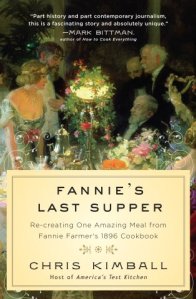 Fried Brain Balls. Calves Foot Jelly. Mock Turtle Soup.
Fried Brain Balls. Calves Foot Jelly. Mock Turtle Soup.
Believe it or not, this was highfalutin’ fine dining when Hugh and Hazlett Campbell were entertaining guests. These recipes — including more palatable ones like Mandarin Cake, Lobster a la Americane and Roast Saddle of Venison — are part of Fannie’s Last Supper, where Chris Kimball of America’s Test Kitchen and Cook’s Illustrated fame attempts to recreate not only Fannie Farmer’s over-the-top 12-course meal, but he did it using the same techniques and equipment a cook would have used back in 1896 when Fannie Farmer’s The Boston Cooking School Cookbook was released.
Although this book was written about food and cooking after Virginia Campbell and her cookbook’s time, Fannie’s Last Supper is a compelling glimpse of the foods, preparation and social life of people of a certain class that is particularly applicable to the turn of the last century, a decadent era when Hugh and Hazlett were certainly entertaining guests at Campbell House.
This isn’t just a cookbook. In addition to the exhaustive recipe testing that America’s Test Kitchen is known for, Kimball discusses American food history and the evolving availability of meats, cheeses and European imports, Victorian cooking techniques and household operations, and even fascinating minutae, like the pros and cons of a coal- vs wood-fired stove (not to mention how you light and cook on the hulking beast).

Two luscious Victorian jellies. Image courtesy of fannieslastsupper.com
All of this is underpinned by the delightful narrative of Kimball’s quest to find an authentic Victorian home (and kitchen!) that had not been updated and/or stylistically butchered by well-meaning residents, learning the best way to boil a calf’s head (clean the inside of the nose, remove the eyes and brain before boiling, natch) and the intellectual process of finding value and relevance of such a complicated, expensive and labor-intensive two-year project that culminates in, well, one dinner.
His argument is compelling: Tools and appliances of convenience have saved us time, but what have we done with all this leisure we supposedly have? Watch TV. Play on Facebook. Surf the internet. Statistically speaking, we aren’t enriching our minds with a new hobby or helping the poor. Cooking, however, is one of those daily chores that occupies our minds and hands and creates a product that puts us in touch (literally) with nature through the raw materials of our endeavor, and the result is shared and enjoyed by those closest to us. Kimball’s not advocating for us to retrofit our homes with cast-iron stoves and primitive ice boxes, but he certainly wants us to relish and appreciate the labor of food preparation because it is through this simple yet fulfilling work that we can be truly happy, content and useful.
Stay tuned to our blog and Facebook and Twitter feeds. We have some really big news about food/eating/general awesomeness at Campbell House that we’ll release over the next several weeks.
In the meantime, to learn more about Chris Kimball’s quest to make Fannie’s big meal, visit the website at www.fannieslastsupper.com. Better yet, pick up the book and try a recipe or two and share the culinary love with the people you love the most.




